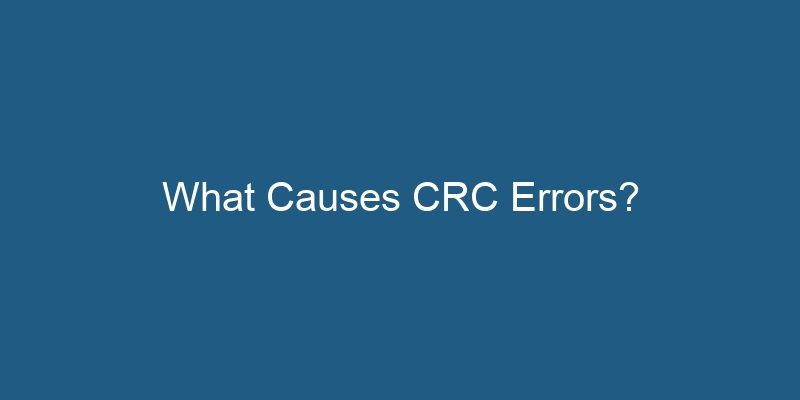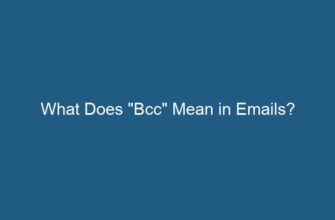A cyclic redundancy check (CRC) is an error-detecting code commonly used in digital networks and storage devices to ensure the integrity of data transmission. When a CRC error occurs, it indicates that the received data has been corrupted during transmission or storage. Understanding the causes of CRC errors is crucial for troubleshooting and preventing data corruption in various systems. In this article, we will delve into the different factors that can lead to CRC errors, their impact, and potential solutions.
- 1. Signal Interference
- 1.1 Electromagnetic Interference (EMI)
- 1.2 Radio Frequency Interference (RFI)
- 2. Transmission Line Noise
- 2.1 Improper Termination
- 2.2 Impedance Mismatches
- 2.3 Crosstalk
- 3. Hardware Failures
- 3.1 Network Interface Card (NIC) Issues
- 3.2 Cable Damage
- 3.3 Storage Device Malfunctions
- 4. Software or Firmware Issues
- 4.1 Bug or Compatibility Issues
- 4.2 Outdated Software/Firmware
- 5. Data Compression or Encryption
- 5.1 Compression-related Errors
- 5.2 Encryption-related Errors
- Conclusion
1. Signal Interference
One of the primary causes of CRC errors is signal interference. When data is transmitted over a network or stored on a device, it travels as electrical or optical signals. However, these signals can be influenced by external factors such as electromagnetic interference (EMI) or radio frequency interference (RFI). This interference can disrupt the integrity of the data, leading to CRC errors.
1.1 Electromagnetic Interference (EMI)
EMI is the interference caused by electromagnetic radiation emitted from electronic devices or power lines. It can occur in various environments, including offices, industrial settings, or even in close proximity to other electronic devices. EMI can corrupt data signals, resulting in CRC errors. Shielding cables and equipment, separating power lines from data lines, or using ferrite cores can help mitigate EMI-related CRC errors.
1.2 Radio Frequency Interference (RFI)
RFI refers to the interference caused by radio frequency electromagnetic waves, such as those emitted by wireless devices or nearby broadcasting stations. RFI can disrupt data transmission or storage, leading to CRC errors. To minimize RFI-related errors, it is essential to keep data cables away from sources of RFI, use shielded cables, and ensure proper grounding of equipment.
2. Transmission Line Noise
Noise on transmission lines can also contribute to CRC errors. Transmission lines carry data signals over long distances, and various factors can introduce noise into the transmission medium. This noise can corrupt the data, leading to CRC errors. Factors such as improper termination, impedance mismatches, crosstalk, or poor cable quality can all contribute to transmission line noise and subsequent CRC errors.
2.1 Improper Termination
Improper termination refers to the incorrect termination of transmission lines, which can lead to signal reflections and subsequent noise. When a signal encounters an impedance mismatch at the end of a transmission line, a portion of the signal reflects back towards the source. This reflected signal interferes with the original signal, causing errors and CRC failures. Ensuring proper termination, such as using termination resistors, can minimize these errors.
2.2 Impedance Mismatches
Impedance mismatches occur when the characteristic impedance of a transmission line does not match the impedance of the connected devices or cables. This mismatch can cause reflections, signal distortions, and ultimately CRC errors. Using cables and devices with matching impedance specifications can help prevent impedance mismatch-related errors.
2.3 Crosstalk
Crosstalk is the phenomenon where signals transmitted on adjacent wires interfere with each other. This interference can corrupt the data signals and result in CRC errors. Proper cable shielding, maintaining appropriate spacing between cables, and using twisted-pair cables can reduce the impact of crosstalk and minimize CRC errors.
3. Hardware Failures
Hardware failures can also be a significant cause of CRC errors. Faulty network interface cards (NICs), damaged cables, or malfunctioning storage devices can all introduce errors into the data transmission or storage process. Identifying and replacing faulty hardware components is crucial to reduce CRC errors caused by hardware failures.
3.1 Network Interface Card (NIC) Issues
A network interface card (NIC) connects a device to a network and plays a vital role in data transmission. However, NICs can develop issues over time, such as damaged connectors or outdated drivers, which can result in CRC errors. Updating drivers, replacing damaged NICs, or using external NICs can help resolve these issues.
3.2 Cable Damage
Cables can suffer physical damage due to factors like bending, pulling, or exposure to environmental hazards. Damaged cables may not transmit data correctly, leading to CRC errors. Regularly inspecting cables, replacing damaged ones, and utilizing cable management techniques can minimize CRC errors caused by cable damage.
3.3 Storage Device Malfunctions
Storage devices, such as hard drives or solid-state drives (SSDs), can experience malfunctions that result in CRC errors during data read or write operations. These malfunctions may be due to factors like bad sectors, firmware issues, or aging components. Regularly monitoring storage health, updating firmware, and replacing failing drives can mitigate CRC errors caused by storage device malfunctions.
4. Software or Firmware Issues
Software or firmware issues can introduce CRC errors in various systems. Bugs, compatibility problems, or outdated software/firmware versions can all contribute to data corruption during transmission or storage. Ensuring up-to-date software/firmware, performing regular system updates, and using reliable software can help minimize CRC errors caused by software or firmware issues.
4.1 Bug or Compatibility Issues
Bugs or compatibility issues in software or firmware can lead to data corruption and subsequent CRC errors. Developers of software or firmware should rigorously test their products and release timely updates to address known issues. Users should also regularly update their software/firmware to benefit from bug fixes and compatibility improvements.
4.2 Outdated Software/Firmware
Using outdated software or firmware versions can increase the risk of CRC errors. Developers regularly release updates to address security vulnerabilities, improve performance, and fix bugs. Users should regularly check for updates and install the latest software/firmware versions to minimize CRC errors caused by outdated software/firmware.
5. Data Compression or Encryption
Data compression or encryption techniques can introduce additional complexity to data transmission or storage, potentially leading to CRC errors. Compression algorithms, such as ZIP or RAR, and encryption algorithms, like AES or RSA, may introduce errors or interfere with error-detection mechanisms. It is crucial to use reliable compression and encryption algorithms and verify data integrity after compression or decryption to mitigate CRC errors.
5.1 Compression-related Errors
Data compression algorithms aim to reduce the size of data by removing redundancies. However, compression errors can occur, and if undetected, they can lead to CRC errors during decompression. Verifying the integrity of compressed data using checksums or hashing algorithms can help identify and mitigate compression-related errors.
5.2 Encryption-related Errors
Encryption algorithms transform data using cryptographic keys, ensuring its confidentiality. However, errors can occur during encryption or decryption, resulting in CRC errors. Verifying the integrity of encrypted data using cryptographic checksums or message authentication codes (MACs) can help detect and address encryption-related errors.
Conclusion
CRC errors can have various causes, ranging from signal interference and transmission line noise to hardware failures and software/firmware issues. Understanding these causes and implementing appropriate measures can help prevent CRC errors and ensure data integrity in digital networks and storage systems. By addressing the specific factors discussed in this article, network administrators, system engineers, and users can minimize the occurrence of CRC errors and maintain reliable data transmission and storage.










